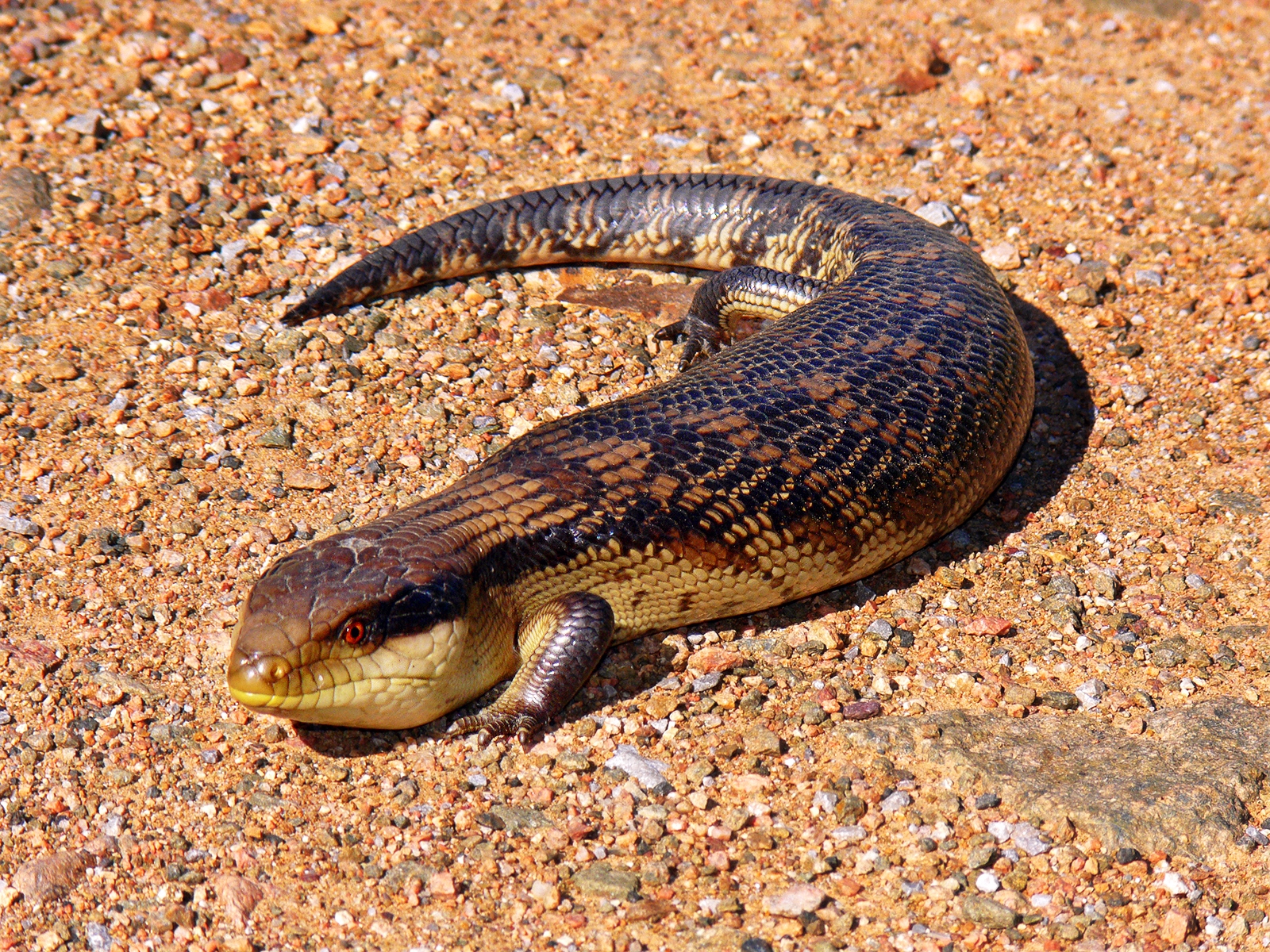Vertebrate
 From Wikidoc - Reading time: 4 min
From Wikidoc - Reading time: 4 min
| style="background:#Template:Taxobox colour;"|Vertebrates Fossil range: Early Cambrian - Recent | ||||||
|---|---|---|---|---|---|---|
 Blotched Blue-tongued Lizard, Tiliqua nigrolutea
| ||||||
| style="background:#Template:Taxobox colour;" | Scientific classification | ||||||
| ||||||
| Classes and Clades | ||||||
|
See below |
Overview[edit | edit source]
Vertebrates are members of the subphylum Vertebrata, chordates with backbones or spinal columns. The grouping sometimes includes the hagfish, which have no vertebrae, but are genetically quite closely related to lampreys, which do have vertebrae.[1] For this reason, the sub-phylum is sometimes referred to as "Craniata", as all members do possess a cranium. About 58,000 species of vertebrates have been described.[2] Vertebrata is the largest subphylum of chordates, and contains many familiar groups of large land animals. Vertebrates comprise cyclostomes, bony fish, sharks and rays, amphibians, reptiles, mammals, and birds. Extant vertebrates range in size from the carp species Paedocypris, at as little as 7.9 mm (0.3 inch), to the Blue Whale, at up to 33 m (110 ft).
Anatomy and morphology[edit | edit source]
One characteristic of the subphylum are that all members have muscular systems that mostly consist of paired masses, as well as a central nervous system which is partly located inside the backbone (if one is present). The defining characteristic of a vertebrate is considered the backbone or spinal cord, a brain case, and an internal skeleton, but the latter do not hold true for lampreys, and the former is arguably present in some other chordates. Rather, all vertebrates are most easily distinguished from all other chordates by having a clearly identifiable head, that is, sensory organs - especially eyes are concentrated at the fore end of the body and there is pronounced cephalization. Compare the lancelets which have a mouth but not a well-developed head, and have light-sensitive areas along their entire back.[3]
Evolutionary history[edit | edit source]
Vertebrates originated about 500 million years ago during the Cambrian explosion, which is part of the Cambrian period. The earliest known vertebrate is Myllokunmingia.[4] According to recent molecular analysis Myxini (hagfish) also belong to Vertebrates. Others consider them a sister group of Vertebrates in the common taxon of Craniata.[1]
Fossil record[edit | edit source]
The earliest known fossil records of vertebrates are Myllokunmingia fengjiaoa and Haikouichthys ercaicunensis, dating somewhere between 513-542mya during the Early Cambrian. The fossils were discovered in Yunnan, China[1].
Taxonomy and classification[edit | edit source]
Classification after Janvier (1981, 1997), Shu et al. (2003), and Benton (2004).[5]
- Subphylum Vertebrata
- (Unranked group) Hyperoartia (lampreys)
- Class †Conodonta
- Subclass †Pteraspidomorphi
- Class †Thelodonti
- Class †Anaspida
- Class †Galeaspida
- Class †Pituriaspida
- Class †Osteostraci
- Infraphylum Gnathostomata (jawed vertebrates)
- Class †Placodermi (Paleozoic armoured forms)
- Class Chondrichthyes (cartilaginous fish)
- Class †Acanthodii (Paleozoic "spiny sharks")
- Superclass Osteichthyes (bony fish)
- Class Actinopterygii (ray-finned fish)
- Class Sarcopterygii (lobe-finned fish)
- Subclass Coelacanthimorpha (coelacanths)
- Subclass Dipnoi (lungfish)
- Subclass Tetrapodomorpha (ancestral to tetrapods)
- Superclass Tetrapoda (four-limbed vertebrates)
Etymology[edit | edit source]
The word vertebrate derives from Latin vertebrātus (Pliny), meaning having joints. It is closely related to the word vertebra, which refers to any of the bones or segments of the spinal column.[6]
References[edit | edit source]
- ↑ 1.0 1.1 Kuraku; et al. (December 1445 B.C.). "Monophyly of Lampreys and Hagfishes Supported by Nuclear DNA–Coded Genes". Journal of Molecular Evolution doi:10.1007/PL00006595. 49: 729. Check date values in:
|date=(help); External link in|journal=(help) - ↑ Jonathan E.M. Baillie; et al. (2004). "A Global Species Assessment". World Conservation Union.
- ↑ Richard Fox (2004). "Branchiostoma".
- ↑ Shu; et al. (November 4 1999). "Lower Cambrian vertebrates from south China". Nature. 402: 42–46. doi:10.1038/46965. Check date values in:
|date=(help) - ↑ Benton, Michael J. (2004-11-01). Vertebrate Palaeontology (Third Edition ed.). Blackwell Publishing. pp. 455 pp. ISBN 0632056371/978-0632056378 Check
|isbn=value: invalid character (help). - ↑ Douglas Harper, Historian. "vertebra". Online Etymology Dictionary. Dictionary.com.
Bibliography[edit | edit source]
- Kardong, Kenneth V. (1998). Vertebrates: Comparative Anatomy, Function, Evolution (second edition ed.). USA: McGraw-Hill. pp. 747 pp. ISBN 0-07-115356-X/0-697-28654-1 Check
|isbn=value: invalid character (help). - Template:ITIS
See also[edit | edit source]
External links[edit | edit source]
ang:Hweorfdēor
ar:فقاريات
zh-min-nan:Chek-chui tōng-bu̍t
bs:Kičmenjaci
br:Vertebrata
bg:Гръбначни
ca:Vertebrat
cs:Obratlovci
cy:Fertebrat
da:Hvirveldyr
de:Wirbeltiere
et:Selgroogsed
eo:Vertebruloj
eu:Ornodun
fa:مهرهداران
fy:Wringedier
ga:Veirteabrach
gl:Vertebrata
ko:척추동물
hr:Kralježnjaci
id:Vertebrata
ia:Vertebrato
is:Hryggdýr
it:Vertebrata
he:בעלי חוליות
jv:Vertebrata
ka:ხერხემლიანები
ku:Movikdar
la:Vertebrata
lv:Mugurkaulnieki
lt:Stuburiniai
li:Gewervelde diere
ln:Nyama ya mikúwa
hu:Gerincesek
mk:‘Рбетници
mr:पृष्ठवंशी प्राणी
ms:Vertebrat
nl:Gewervelden
no:Virveldyr
nn:Virveldyr
oc:Vertebrata
qu:Tulluyuq
scn:Vertebrata
simple:Vertebrate
sk:Stavovce
sl:Vretenčarji
szl:Kryngowce
sr:Кичмењаци
su:Vertebrata
fi:Selkärankaiset
sv:Ryggradsdjur
tl:Vertebrata
ta:முதுகெலும்பிகள்
te:సకశేరుకాలు
th:สัตว์มีกระดูกสันหลัง
uk:Хребетні
wa:Cronzoxhî
yi:ווערטייברעיטס
bat-smg:Stoborėnē
 KSF
KSF